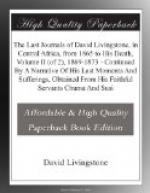12th July, 1872.—Two men come from Syde bin Habib report fighting as going on at discreet distances against Mirambo.
Sheikh But, son of Mohamad bin Saleh, is found guilty of stealing a tusk of 2-1/2 frasilahs from the Lewale. He has gone in disgrace to fight Mirambo: his father is disconsolate, naturally. Lewale has been merciful.
When endeavouring to give some account of the slave-trade of East Africa, it was necessary to keep far within the truth, in order not to be thought guilty of exaggeration; but in sober seriousness the subject does not admit of exaggeration. To overdraw its evils is a simple impossibility. The sights I have seen, though common incidents of the traffic, are so nauseous that I always strive to drive them from memory. In the case of most disagreeable recollections I can succeed, in time, in consigning them to oblivion, but the slaving scenes come back unbidden, and make me start up at dead of night horrified by their vividness. To some this may appear weak and unphilosophical, since it is alleged that the whole human race has passed through the process of development. We may compare cannibalism to the stone age, and the times of slavery to the iron and bronze epochs—slavery is as natural a step in human development as from bronze to iron.
Whilst speaking of the stone age I may add that in Africa I have never been fortunate enough to find one flint arrowhead or any other flint implement, though I had my eyes about me as diligently as any of my neighbours. No roads are made; no lands levelled; no drains digged; no quarries worked, nor any of the changes made on the earth’s surface that might reveal fragments of the primitive manufacture of stone. Yet but little could be inferred from the negative evidence, were it not accompanied by the fact that flint does not exist in any part south of the equator. Quartz might have been used, but no remains exist, except the half-worn millstones, and stones about the size of oranges, used for chipping and making rough the nether millstone. Glazed pipes and earthenware used in smelting iron, show that iron was smelted in the remotest ages in Africa. These earthenware vessels, and fragments of others of a finer texture, were found in the delta of the Zambesi and in other parts in close association with fossil bones, which, on being touched by the tongue, showed as complete an absence of animal matter as the most ancient fossils known in Europe. They were the bones of animals, as hippopotami, water hogs, antelopes, crocodiles, identical with those now living in the country. These were the primitive fauna of Africa, and if vitrified iron from the prodigious number of broken smelting furnaces all over the country was known from the remotest times, the Africans seem to have had a start in the race, at a time when our progenitors were grubbing up flints to save a miserable existence by the game they might kill. Slave-trading seems to have been coeval with the knowledge of iron. The monuments of Egypt show that this curse has venerable antiquity. Some people say, “If so ancient, why try to stop an old established usage now?” Well, some believe that the affliction that befel the most ancient of all the patriarchs, Job, was small-pox. Why then stop the ravages of this venerable disease in London and New York by vaccination?




